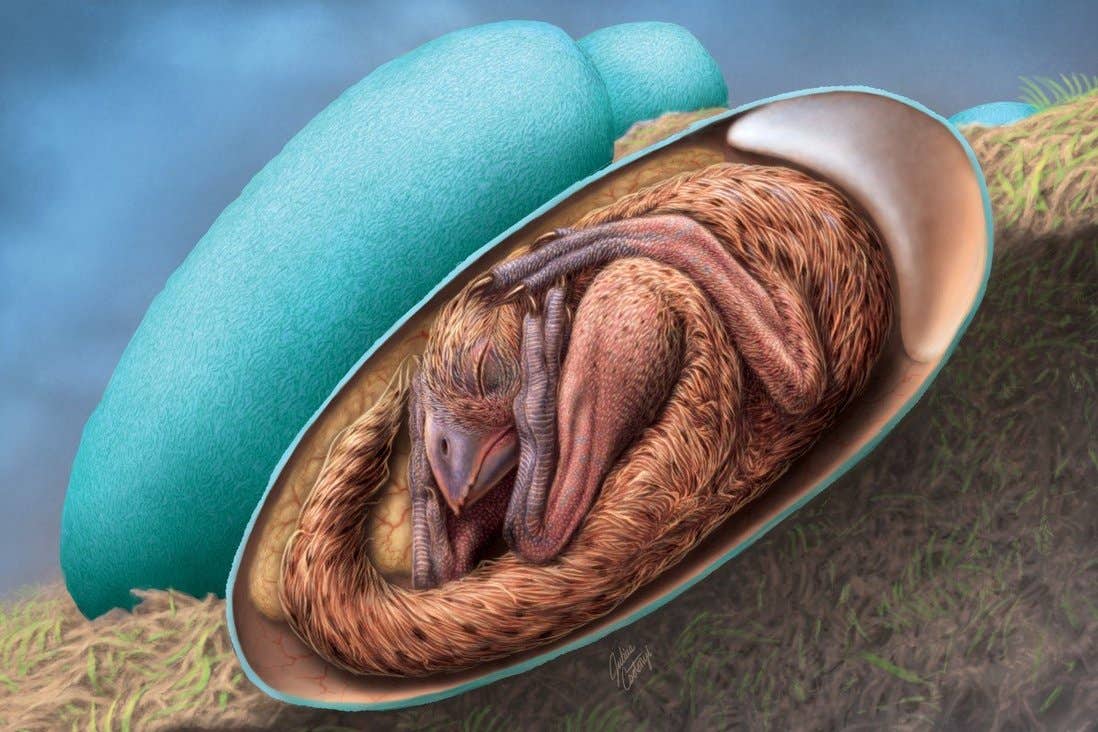Global first: Baby dinosaur found inside 70-million-year-old fossilized egg
In an astounding discovery, a fossilized dinosaur egg, dating back approximately 70 million years, has been uncovered in China.

[Oct. 2, 2023: Staff Writer, The Brighter Side of News]
An artist’s reconstruction of a baby oviraptorosaur in its egg. (CREDIT: Julius Csotonyi)
In an astounding discovery that has electrified the scientific community, a fossilized dinosaur egg, dating back approximately 70 million years, has been uncovered in China. This momentous find is not just any fossil; it holds within it crucial insights into the mysterious world of dinosaur incubation.
The discovery took place in Fuzhou, located in the Fujian Province of China. The egg has been affectionately christened as 'Baby Yingliang,' named after the prestigious Yingliang Stone Nature History Museum, where it is now showcased. The fossil immaculately enshrines the embryonic structure of an oviraptorid dinosaur, displaying the infant creature snuggly curled up inside.
Highlighting the rarity and significance of such a discovery, Darla Zelenitsky, an associate professor in the Department of Geoscience at the University of Calgary in Canada, said, "It is an amazing specimen... I have been working on dinosaur eggs for 25 years and have yet to see anything like it."
She emphasized the previously limited knowledge scientists had regarding the world within a dinosaur's egg prior to hatching. This was mainly due to the dearth of complete and well-preserved embryonic skeletons.
Related Stories
Furthermore, it was revealed during a press conference, that another embryonic fossil, nearing its hatching stage, had been located in the Ganzhou, Jiangxi Province of China.
The fossil in question is that of an oviraptorosaur, a group of bird-like theropod dinosaurs that thrived during the Cretaceous Period, the third and final time period of the Mesozoic Era (commonly known as the 'Age of Dinosaurs') that extended from 145 to 66 million years ago. The new specimen was recovered from uppermost Cretaceous-aged rocks, some 70 million years old, in Ganzhou City in southern China's Jiangxi Province.
The fossil consists of an incomplete skeleton of a large, presumably adult oviraptorid crouched in a bird-like brooding posture over a clutch of at least 24 eggs. At least seven of these eggs preserve bones or partial skeletons of unhatched oviraptorid embryos inside.
The fossil consists of an incomplete skeleton of a large, presumably adult oviraptorid crouched in a bird-like brooding posture over a clutch of at least 24 eggs. (CREDIT: LIDA XING)
The late stage of development of the embryos and the close proximity of the adult to the eggs strongly suggests that the latter died in the act of incubating its nest, like its modern bird cousins, rather than laying its eggs or simply guarding its nest crocodile-style, as has sometimes been proposed for the few other oviraptorid skeletons that have been found atop nests.
The latest findings also draw intriguing parallels between theropod dinosaurs and the avian species we know today. This connection has been delved into extensively in a study released in the esteemed journal, iScience.
Skeleton of oviraptorid embryo (YLSNHM01266). In (A) dorsal view of skull; (B) dorsal view of cervical and dorsal vertebrae; (C) dorsal view of posterodorsal vertebrae and pelvic region. (CREDIT: iScience)
The study provided a descriptive analysis, stating, "The head lies ventral to the body, with the feet on either side, and the back curled along the blunt pole of the egg, in a posture previously unrecognized in a non-avian dinosaur, but reminiscent of a late-stage modern bird embryo."
Taking the comparison a step further, the research postulated that certain prehatch oviraptorids might have manifested avian-like postures during the latter part of incubation. In modern birds, these positions are pivotal for coordinated embryonic movements related to tucking.
Oviraptorid embryo inside an elongatoolithid egg (YLSNHM01266). Abbreviations: cev, cervical vertebra; cv, caudal vertebra; dv, dorsal vertebra; f, femur; fi, fibula; II-1, pedal phalanx II-1; il, ilium; is, ischium; m, mandible; mt-I, metatarsal I; mt-III, metatarsal III; mx, maxilla; p, pubis; pm, premaxilla; r, radius; s, scapula; t, tibia; ul, ulna. Scale is 1 cm. (CREDIT: iScience)
This behavior, orchestrated by the central nervous system, plays a vital role in ensuring a successful hatching process. The research surmises, "We propose that such pre-hatching behavior, previously considered unique to birds, may have originated among non-avian theropods. Future discoveries of embryo fossils could shed more light on this hypothesis."
Fion Waisum Ma, a distinguished paleontologist at the University of Birmingham in the United Kingdom and a lead author of the said study, chimed in on the matter. She noted the unique posture of the embryonic skeleton, which strikingly mirrors features observed in birds.
In-ovo late-stage embryos of non-avian and avian dinosaurs. Oviraptorid specimens (MPC 100/971, YLSNHM01266 & IVPP V20183), which potentially correspond to various tucking stages. (CREDIT: iScience)
She stated, "Up until this point, the tucking posture had only been seen in birds." Elaborating further, Ma explained, "Some embryos are quite well preserved, but they don't show this posture. And some are very fragmentary, making it challenging to discern their posture with clarity."
This groundbreaking revelation has unquestionably deepened our understanding of the intricate evolutionary ties binding dinosaurs and birds. As researchers and scientists continue their relentless pursuit of knowledge, these ancient fossils are poised to play a pivotal role, offering precious glimpses into the prehistoric world and the mysteries it holds.
The ongoing excavations and continuous research in the realm of paleontology are not just about uncovering the past; they are about understanding the evolutionary trajectory and unlocking the secrets that have shaped the world as we know it today. The discovery of 'Baby Yingliang' is not just a testament to the wonders of the past, but also a beacon guiding us into the future of scientific exploration.
For more science news stories check out our Discoveries section at The Brighter Side of News.
Note: Materials provided above by the The Brighter Side of News. Content may be edited for style and length.
Like these kind of feel good stories? Get the Brighter Side of News' newsletter.



